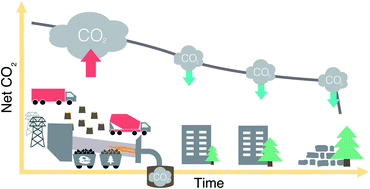Curing time: a temporally explicit life cycle CO2 accounting of mineralization, bioenergy, and CCS in the concrete sector†
Abstract
The decarbonization of concrete production requires a multi-pronged approach including the abatement of CO2 emissions from cement production as well as storage of CO2 within concrete itself. This study explores the decarbonization potential of combining bioenergy and carbon capture and storage (CCS) during cement production with the accelerated carbonation of fresh concrete and the natural carbonation of demolished concrete for the life cycle net CO2 of 30 MPa ordinary Portland concrete. As both biomass and concrete reuptake CO2 over time, the timing of CO2 emissions and removals is explicitly accounted for. At current technology levels, the combination of bioenergy and CCS in cement production combined with the carbonation of demolished concrete was seen in our model to allow for net CO2-negative concrete. However, the concrete is CO2-positive until the CO2 of production is reabsorbed by biomass regrowth and the carbonation of demolished concrete at end-of-life. In our model, accelerated carbonation was, by itself, an inefficient CO2 storage mechanism, due to the penalty of energy use and injection losses. However, if it led to a gain in concrete strength, accelerated carbonation could result in lower CO2via reduced resource demand and cement production.

- This article is part of the themed collection: Carbon dioxide utilisation


 Please wait while we load your content...
Please wait while we load your content...